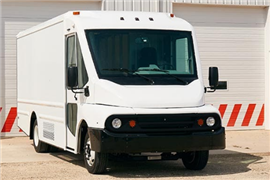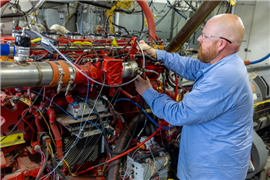Read this article in Français Deutsch Italiano Português Español
Why are mini excavators still increasing in popularity and who’s buying them?
10 June 2024
The mini, but mighty, machines are continually growing in popularity. Catrin Jones takes a look at some of the newest developments and what is next for the well-loved compact machine.
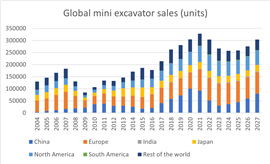 Chris Sleight, managing director at UK-based Off-Highway Research, says that the cyclical ebbs and flows of the market mean the growth rate depends on the start and finish point one chooses (Photo: International Construction)
Chris Sleight, managing director at UK-based Off-Highway Research, says that the cyclical ebbs and flows of the market mean the growth rate depends on the start and finish point one chooses (Photo: International Construction)
The popularity of mini excavators continues to grow steadily each year. Their small size and versatility have made them a popular choice for over 20 years. There is no indication that this trend will slow down, as manufacturers continuously improve the machines’ capabilities.
Industry research and analysis specialists Off-Highway Research reported that over 365,000 mini excavators were sold globally last year, valued at more than US$12.5 billion.
Not only this, but mini excavators have shown some of the best long-term global growth of any construction equipment machine.
Chris Sleight, managing director at UK-based Off-Highway Research, says that the cyclical ebbs and flows of the market mean the growth rate depends on the start and finish point one chooses. However, looking back over the last 20 years shows that global sales of mini excavators have grown on average 5-6% per year.
Sleight adds, “They are the highest volume machines in China, Europe and Japan and are second only to the phenomenally popular compact tracked loader in North America.
“Although demand has grown around the world over the last 20 years, it is emerging markets where the rise has been the steepest. Long-term growth in the developed markets of Europe, Japan and North America has moved along at a respectable 3-4% per year on average, but for the rest of the world the figure has been 13-14%.”
This has meant that there has been a shift in where demand for these machines comes from. In the early 2000s, says Sleight, sales were split roughly 70:30 between mature and emerging markets. Today, that has shifted to 60:40.
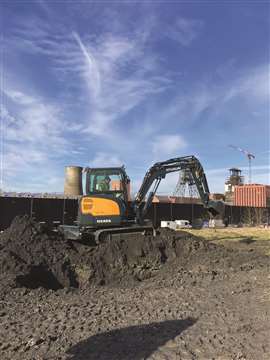 At an event for the press, the full lineup from HD Hyundai was launched in February (Photo: International Construction)
At an event for the press, the full lineup from HD Hyundai was launched in February (Photo: International Construction)
New launches in the market
With the steady growth of mini excavators come new and improved models from some of the world’s largest OEMs.
JCB unveiled the new 26 C-1 mini excavator at its UK-based headquarters in February. The 26 C-1 is a 2.5-tonne mini excavator, which is said to fill a weight gap in JCB’s machine range.
The unit uses a three-cylinder KSD engine from Kohler and can produce 18.4kW (24.6hp) at 2200rpm in addition to delivering a maximum torque of 90Nm at 1800rpm.
The mini excavator was said to be redesigned from the ground up using all-steel bodywork. Other key features of the machine include hoses routed through the boom to improve visibility and a new bucket design. There is also an automated ‘health check’ at start-up to support machine maintenance.
Volvo Construction Equipment (Volvo CE) replaced three of its compact excavator models at the start of the year with two new tracked models, the EC37 and the ECR40.
Replacing the company’s EC35D, ECR35D and ECR40D machines, the new EC37 and ECR40 are designed specifically for contractors in North America.
They offer upgraded features for operator comfort and are said to be 10% more fuel efficient than the company’s previous models, while also offering better stability and easier maintenance.
Earlier this year, HD Hyundai Construction Equipment Europe unveiled at a launch event in Belgium an additional eight mini excavators to form a 12-model range with operating weights of 1.7 to 5.5 tonnes.
Hyundai says that the line-up will be completed in the second quarter of 2024 with models weighing 2.5, 3.0, and 5.0 tonnes.
“The launch of the A-Series mini excavators by HD Hyundai is part of our strategy to have a more prominent presence in the growing European compact segment,” said Peter Sebold, product manager for mini excavators at HD Hyundai Construction Equipment Europe.
While all models have compact dimensions, those with a ‘z’ suffix feature a zero-tail swing design. The company says that the zero tail swing machines can be supplied with additional counterweight if required, to increase stability during heavy lifting operations. Variable-width undercarriages on the smaller models are also available to deliver maximum stability for heavy digging and lifting tasks.
Sebold spoke to International Construction at the launch event and highlighted that Hyundai’s launch in Europe follows a successful release of the machines on other continents.
“America was the first request,” says Sebold. “We looked around in Europe and we saw that some of our competitors have machines in those size classes. So, we said, OK, lets bring it on and let us see how it works here in Europe.
“For us, it’s a new segment, it’s a new size class of mini excavators, but we are all positive with the new range and with the new features.”
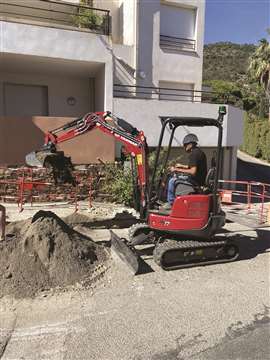 The Yanmar ViO17 (Photo: Yanmar)
The Yanmar ViO17 (Photo: Yanmar)
Continued growth
Many OEMs have seen rising demand for an extended lineup of mini excavators; why is the machine still growing in popularity?
“There’s always a need for small machines,” responds Sebold. “Our modern world is getting increasingly urbanized. We are becoming more centered around big cities and environments. You have everything like pipe laying, fiber internet cables, water, gas, all of this.
“Usually in the city, you do not have much space. So that is one reason short-radius machines are becoming increasingly popular. Also, it is a safety aspect. While the machine works, the operator can focus on their tasks without worrying about monitoring the machine.”
That is a growing demand for more compact machines, either as a result of natural evolution or due to advancements in technology.
He continues, “In the previous ranges of mini excavators, we had a small display – now we come with a fully digital CD display of five inches. It is still small, but we have it available on the full range of machines.
“I think that is already something outstanding; to have a 1.7 tonne mini excavator fitted with a full digital machine display.”
Technology is a key component of the mini excavator lineup for all OEMs. Pascal Duponcheele, senior product manager at Yanmar, says that the construction industry’s shift towards digitalization will see mini excavators at the forefront of incorporating technological innovations.
“Over the next five to ten years, connectivity, artificial intelligence, and automation will become increasingly prevalent in compact equipment, with the heavy equipment industry leading these advancements,” he says.
“Making the right choices between the cost of technology and the cost of the machine is crucial. Our focus areas include machine operation assistance, task automation, safety, and remote monitoring through telematics. Currently, we are concentrating on deploying telematics and leveraging the data it generates, with other streams being developed.”
Potential to do more
For Andreas Gstoettenbauer, head of product management at Wacker Neuson Linz, while telematic systems are already incorporated into current machines, there is the potential to do much more.
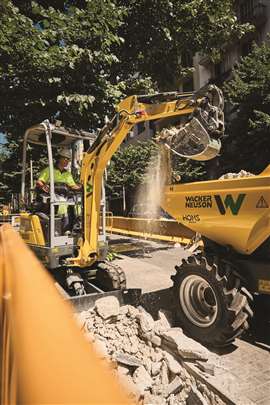 A Wacker Neuson EZ17e in action (Photo: Wacker Neuson)
A Wacker Neuson EZ17e in action (Photo: Wacker Neuson)
“What we mostly see today, is the tracking of working hours and machine position,” says Gstoettenbauer.
“2D and 3D solution technology from bigger machines are now being integrated into smaller excavators, which is also helping smaller construction sites in working with digital plans or at least digitally supported positioning and measuring.”
He highlights the company’s Machines in Construction 4.0 (MiC 4.0) as a tool to help advance digital solutions. This is a manufacturer-independent data interface between attachment tools and construction machinery that displays all relevant use cases for communication between construction machinery and attachments.
As we look to the future, what is next for mini excavators? Yanmar’s Duponcheele says that the rise of compact machines has been – and will continue to be – driven by new markets, customer types, attachments, and alternative powertrains.
“Compact machines, especially mini excavators, have evolved from being viewed merely as smaller versions of larger equipment to becoming essential, multifunctional tools within the construction landscape,” he comments.
“This evolution is fuelled by economic development, labour market shifts, and technological advancements, making compact equipment indispensable in both developed and emerging markets.”
The ongoing integration of new technologies, such as sensor technology, connectivity, and automation, further cements the crucial role of mini excavators in increasing productivity, reducing ownership costs, and meeting the diverse needs of construction.
POWER SOURCING GUIDE
The trusted reference and buyer’s guide for 83 years
The original “desktop search engine,” guiding nearly 10,000 users in more than 90 countries it is the primary reference for specifications and details on all the components that go into engine systems.
Visit Now
STAY CONNECTED




Receive the information you need when you need it through our world-leading magazines, newsletters and daily briefings.
CONNECT WITH THE TEAM












